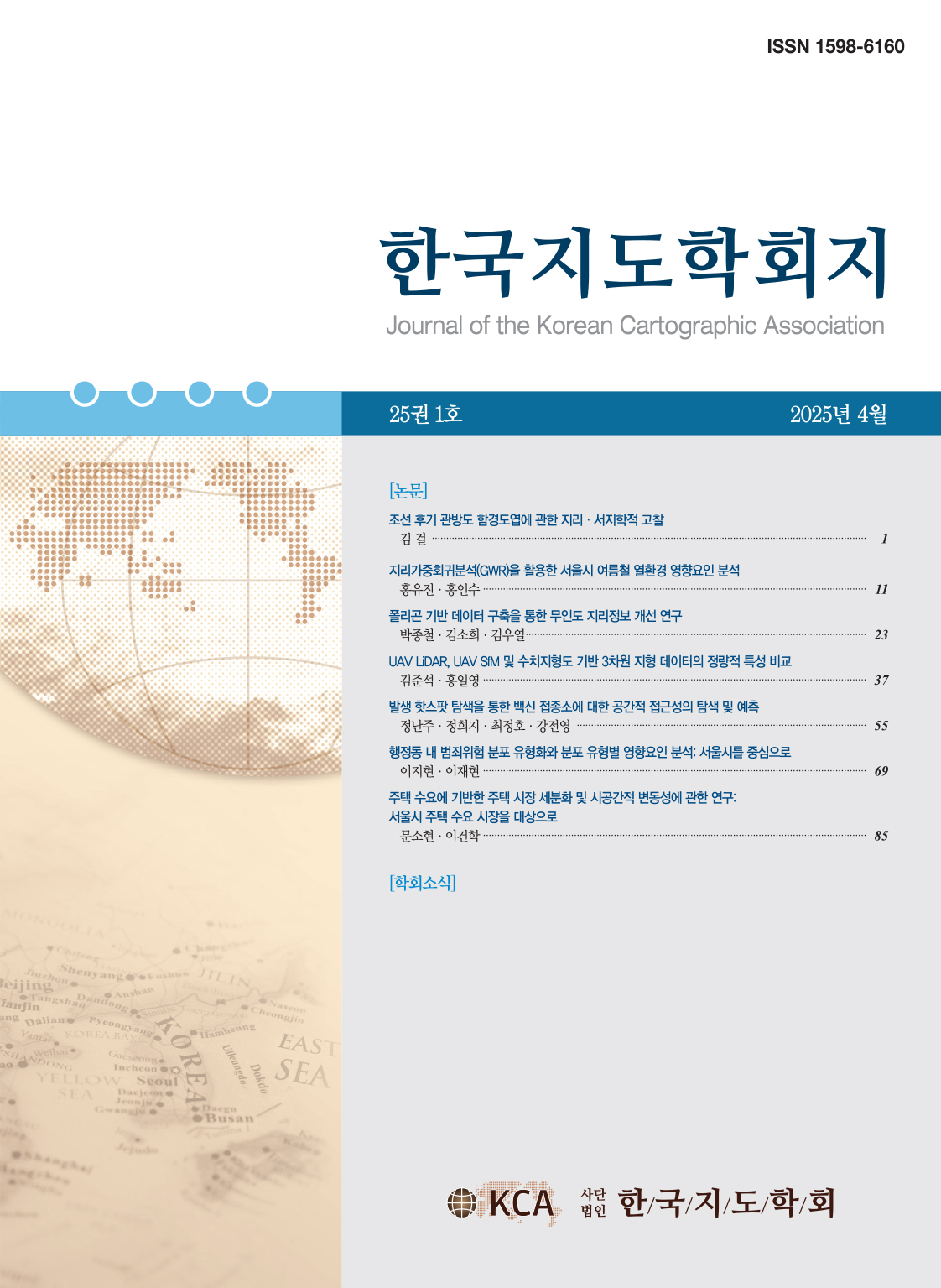Research Article
Abstract
References
Information
Coronavirus Disease 2019 (COVID-19) Pandemic has raised the necessity of more effective visualization of vast data with expanded spatiotemporal dimensions. The purpose of this paper is to review the COVID-19 mapping trends and to suggest alternatives of mapping techniques that represent the spatiotemporal dimensions of the epidemic. To this end, this paper has reviewed studies that include discussions regarding mapping or geovisualization of COVID-19. The most commonly used technique for providing COVID-19 information is dashboard, which has limitations that they can’t reflect the dynamic of the epidemic as static map. To make up for these limitations, there have been various attempts to reflect temporal dimensions on the map, including the utilization of graphs as map symbols, and animations. Based on the review of prior study, this paper applied temporal strips and the Dorling catogram algorithm to suggest an alternative geovisualization techniques that can help map readers intuitively recognizes spatial patterns and temporal trends of phenomena on maps. This paper has cartographic significance in that it identified the possibility of map-making with expanded spatiotemporal dimensions in the Pandemic era.
코로나바이러스감염증-19(COVID-19) 팬데믹 이후 시공간적 차원이 확대된 방대한 데이터를 보다 효과적으로 시각화할 필요성이 대두되었다. 본 연구의 목적은 COVID-19의 지도화 동향을 검토하고, 지도상에서 감염병의 시공간적 차원을 함께 재현하는 대안적 지도화 방안을 모색하는 것이다. 이를 위하여 COVID-19 데이터의 지도화 또는 지리적 시각화 관련 지도학적 논의를 포함하는 연구들을 광범위하게 검토하였다. COVID-19 정보 제공을 위해 가장 보편적으로 사용되는 기법인 대시보드는 정적 지도로서, 시공간적 차원이 동시에 변화하는 COVID-19의 역동성을 보여주지 못한다는 한계를 지닌다. 이러한 한계를 보완하기 위하여 지도 기호로서 그래프의 활용, 애니메이션 등 지도상에 시간적 차원을 반영하는 다양한 시도가 있었다. 선행연구 검토를 토대로, 본 연구는 시계열 스트립과 Dorling 카토그램 알고리즘을 적용하여 지도상에서 현상의 공간적 패턴과 시간에 따른 추이를 직관적으로 인지할 수 있는 대안적인 지리적 시각화 방안을 제시하였다. 본 연구는 팬데믹 시대에서 시공간적 차원이 확대된 지도 제작의 가능성을 확인하였다는 점에서 지도학적 의의를 가진다.
- 구양미, 2020, "코로나19와 한국의 글로벌가치사슬(GVC) 변화," 한국경제지리학회지, 23(3), 209-228.
- 김감영, 2001, "GIS와 애니메이션을 이용한 시공간 자료의 지리적 시각화," 한국지도학회지, 1(1), 25-39.
- 박선엽, 2020, "코로나바이러스감염증 2019(코로나19) 확산과 대기 중 PM10 및 PM2.5 농도 변화 간의 연관성: 대구광역시 사례 분석," 대한지리학회지, 55(5), 553-465.
- 박수경, 2021, "코로나 이후 일상생활에서의 돌봄에 대한 지리학적 연구: 청년층 관점을 중심으로," 한국지역지리학회지, 27(1), 40-54. 10.26863/JKARG.2021.2.27.1.40
- 박연정・조일현, 2014, "학습 분석학 기반 대시보드의 설계와 적용," 교육정보미디어연구, 20(2), 191-216. 10.15833/KAFEIAM.20.2.3
- 박진우・최문기・강전영, 2021, "코로나-19 팬데믹 시대의 사회적 거리두기 단계에 따른 대규모 스포츠 경기장 좌석 배치의 공간적 최적화," 대한지리학회지, 56(1), 53-66.
- 박혜정, 2020, "포스트코로나 시대의 도시계획: 휴머니즘 시각의 재고," 한국경제지리학회지, 23(2), 247-261.
- 안재성・이양원・김화환, 2014, "지도 기반 내러티브 시각화를 통한 시공간 정보 전달 방안 연구," 국토지리학회지, 48(4), 547-557.
- 안재성・최진무・이상원・함정수, 2020, "시공간 자료 지리적 시각화를 통한 코로나바이러스감염증-19 확진자 시공간 이동경로 분석에 관한 연구," 한국지도학회지, 20(3), 13-22. 10.16879/jkca.2020.20.3.013
- 이건학・김감영・김영호・김영훈・신정엽・이상일 역, 2014, 「지도학과 지리적 시각화」, 시그마프레스(Slocum, T.A., McMaster, R.B., Kessler, F.C., and Howard, H.H.,
Thematic Cartography and Geovisualization , 3rd ed., NJ : Pearson/Prentice Hall). - 이병민, 2020, "포스트코로나 시대 접경지역 발전 전략," 한국경제지리학회지, 23(3), 229-246. 10.15235/jir.2020.12.23.4.229
- 이성호・최석환, 2020, "신용카드 빅데이터를 활용한 코로나19 발생의 지역상권 영향 분석: 수원시를 사례로," 공간과 사회, 30(3), 167-208.
- 윤진옥・김감영, 2019, "주제도 디자인이 지리적 사실 이해에 미치는 영향," 한국지도학회지, 19(2), 53-63. 10.16879/jkca.2019.19.2.053
- 최우성・하지민・홍성연, 2021, "신종코로나바이러스감염증 확산 시기의 내외국인 간 공간적 분리 변화: 서울시 가리봉동과 대림2동의 비교," 한국지도학회지, 21(1), 53-64. 10.16879/jkca.2021.21.1.053
- 허정원・장주영, 2020, "코로나19 확산시기 서울시 외국인 밀집지역의 지역특성과 생활인구 변화," 공간과 사회, 30(3), 99-137.
- Ahasan, R., Alam, M.S., Chakraborty, T., and Hossain, M.M., 2020, Applications of GIS and geospatial analyses in COVID-19 research: a systematic review,
F1000Research , 9(1379), 1379. 10.12688/f1000research.27544.1 - Beecham, R., Dykes, J., Hama, L., and Lomax, N., 2021, On the use of 'Glyphmaps' for analysing the Scale and temporal spread of COVID-19 reported cases,
ISPRS International Journal of Geo-Information , 10(4), 213. 10.3390/ijgi10040213 - Beltrán, E.T.M., Pérez, M.Q., Pastor-Galindo, J., Nespoli, P., Clemente, F.J.G., and Mármol, F.G., 2021, COnVIDa: COVID-19 multidisciplinary data collection and dashboard,
Journal of Biomedical Informatics , 117, 103760. 10.1016/j.jbi.2021.103760 33798715 PMC8007529 - Bernasconi, A. and Grandi, S., 2021, A conceptual model for geo-online exploratory data visualization: The case of the COVID-19 Pandemic,
Information , 12(2), 69. 10.3390/info12020069 - Boulos, M.N.K. and Geraghty, E.M., 2020, Geographical tracking and mapping of coronavirus disease COVID-19/severe acute respiratory syndrome coronavirus 2 (SARS-CoV-2) epidemic and associated events around the world: how 21st century GIS technologies are supporting the global fight against outbreaks and epidemics,
International Journal of Health Geographics , 19(1), 8. 10.1186/s12942-020-00202-8 32160889 PMC7065369 - Dangermond, J., De Vito, C., and Pesaresi, C., 2020, Using GIS in the time of the COVID-19 crisis, casting a glance at the future. A joint discussion,
J-READING Journal of Research and Didactics in Geography , 1(9), 195-205. - Denice, P., Choi, K.H., Haan, M., and Zajacova, A., 2020, Visualizing the geographic and demographic distribution of COVID-19,
Socius , 6, 237802312 0948715. 10.1177/2378023120948715 - Dong, E., Du, H., and Gardner, L., 2020, An interactive web-based dashboard to track COVID-19 in real time,
The Lancet Infectious Diseases , 20(5), 533-534. 10.1016/S1473-3099(20)30120-1 - Everts, J., 2020, The dashboard pandemic,
Dialogues in Human Geography , 10(2), 260-264. 10.1177/2043820620935355 - Few, S., 2004, Dashboard confusion,
Intelligent Enterprise , March 20, 2004. - Franch-Pardo, I., Napoletano, B.M., Rosete-Verges, F., and Billa, L., 2020, Spatial analysis and GIS in the study of COVID-19. A review,
Science of The Total Environment , 739, 140033. 10.1016/j.scitotenv.2020.140033 32534320 PMC7832930 - Gao, S., Rao, J., Kang, Y., Liang, Y., and Kruse, J., 2020, Mapping county-level mobility pattern changes in the United States in response to COVID-19,
SIGSpatial Special , 12(1), 16-26. 10.1145/3404111.3404115 - Griffin, A.L., MacEachren, A,M., Haedisty, F., Steiner, E., and Li B., 2006, A comparison of animated maps with static small-multiple maps for visually identifying space-time clusters,
Annals of the Association of American Geographers , 96(4), 740-753. 10.1111/j.1467-8306.2006.00514.x - Griffin, A.L., 2020, Trustworthy maps,
Journal of Spatial Information Science , 2020(20), 5-19. 10.5311/JOSIS.2020.20.654 - Hohl, A., Delmelle, E.M., Desjardins, M.R., and Lan, Y., 2020, Daily surveillance of COVID-19 using the prospective space-time scan statistic in the United States,
Spatial and Spatio-temporal Epidemiology , 34, 100354. 10.1016/j.sste.2020.100354 32807396 PMC7320856 - Ivanković, D., Barbazza, E., Bos, V., Fernandes, Ó.B., Gilmore, K.J., Jansen, T., Kara, P., Larrain, N., Lu, S., Meza-Torres, B., Mulyanto, J., Poldrugovac, M., Rotar, A., Wang, S., Willmington, C., Yang, Y., Yelgezekova, Z., Allin, S., Klazinga, N., and Kringos, D., 2021, Features constituting actionable COVID-19 dashboards: descriptive assessment and expert appraisal of 158 public web-based COVID-19 dashboards,
Journal of Medical Internet Research , 23(2), e25682. 10.2196/25682 33577467 PMC7906125 - Juergens, C., 2020, Trustworthy COVID-19 mapping: geo-spatial data literacy aspects of choropleth maps,
KN-journal of Cartography and Geographic Information , 70(4), 155-161. 10.1007/s42489-020-00057-w 33134849 PMC7583689 - Kent, A.J., 2020, Mapping and counter-mapping COVID-19: From crisis to cartocracy,
The Cartographic Journal , 57(3), 187-195. 10.1080/00087041.2020.1855001 - Kitchin, R., Lauriault, T.P., and McArdle, G., 2015, Knowing and governing cities through urban indicators, city benchmarking and real-time dashboards,
Regional Studies, Regional Science , 2(1), 6-28. 10.1080/21681376.2014.983149 - Lan, Y., Desjardins, M.R., Hohl, A., and Delmelle, E., 2021, Geovisualization of COVID-19: State of the art and opportunities,
Cartographica: The International Journal for Geographic Information and Geovisualization , 56(1), 2-13. 10.3138/cart-2020-0027 - Leung, C.K., Chen, Y., Hoi, C.S., Shang, S., Wen, Y., and Cuzzocrea, A., 2020, Big data visualization and visual analytics of COVID-19 data,
2020 24th International Conference Information Visualisation (IV) , 415-420, IEEE. 10.1109/IV51561.2020.00073 32398131 PMC7218487 - MacEachren, A.M., Boscoe, F.P., Haug, D., and Pickle, L.W., 1998, Geographic visualization: Designing manipulable maps for exploring temporally varying georeferenced statistics,
Proceedings IEEE Symposium on Information Visualization (Cat. No. 98TB100258) , 87-94. - Marvel, S.W., House, J.S., Wheeler, M., Song, K., Zhou, Y.H., Wright, F.A., Wright, F.A., Chiu, W.A., Rusyn, I., Motsinger-Rief, A., and Reif, D.M., 2021, The COVID-19 Pandemic Vulnerability Index (PVI) Dashboard: Monitoring county-level vulnerability using visualization, statistical modeling, and machine learning,
Environmental Health Perspectives , 129(1), 017701. 10.1289/EHP8690 33400596 PMC7785295 - Mocnik, F.B., Raposo, P., Feringa, W., Kraak, M.J., and Köbben, B., 2020, Epidemics and pandemics in maps-the case of COVID-19,
Journal of Maps , 16(1), 144-152. 10.1080/17445647.2020.1776646 - Mooney, P. and Juhász, L., 2020, Mapping COVID-19: How web-based maps contribute to the infodemic,
Dialogues in Human Geography , 10(2), 265-270. 10.1177/2043820620934926 - Muhareb, R. and Giacaman, R., 2020, Tracking COVID-19 responsibly,
The Lancet , 10.1016/S0140-6736(20)30693-0 - Müller, H. and Louwsma, M., 2021, The role of spatio-temporal information to govern the COVID-19 pandemic: A european perspective,
ISPRS International Journal of Geo-Information , 10(3), 166. 10.3390/ijgi10030166 - Pappas, L. and Whitman, L., 2011, Riding the technology wave: Effective dashboard data visualization,
Symposium on Human Interface , 6771, 249-258. 10.1007/978-3-642-21793-7_29 - Paszto, V., Burian, J., and Macku, K., 2020, Covid-19 data sources: Evaluation of map applications and analysis of behavior changes in europe's population,
Geografie , 125, 171-209. 10.37040/geografie2020125020171 - Porta, M., 2014,
A Dictionary of Epidemiology , Oxford: Oxford University Press. - Rose-Redwood, R., Kitchin, R., Apostolopoulou, E., Rickards, L., Blackman, T., Crampton, J., and Buckley, M., 2020, Geographies of the COVID-19 pandemic,
Dialogues in Human Geography , 10(2), 97-106. 10.1177/2043820620936050 PMC7335941 - Roy, A.N., Jose, J., Sunil, A., Gautam, N., Nathalia, D., and Suresh, A., 2020, Prediction and spread visualization of COVID-19 pandemic using machine learning,
Preprints , 2020050147. - Samet, H., Han, Y., Kastner, J., and Wei, H., 2020, Using animation to visualize spatio-temporal varying COVID-19 data,
Proceedings of the 1st ACM SIGSPATIAL International Workshop on Modeling and Understanding the Spread of COVID-19 , 53-62. 10.1145/3423459.3430761 - Saran, S., Singh, P., Kumar, V., and Chauhan, P., 2020, Review of geospatial technology for infectious disease surveillance: Use case on COVID-19,
Journal of the Indian Society of Remote Sensing , 1-18. 10.1007/s12524-020-01140-5 - Seaman, V., 1798, An inquiry into the cause of the prevalence of the yellow fever in New-York,
The Medical Repository , 1, 315-332. - Shaito, M. and Elmasri, R., 2021, Map visualization using spatial and spatio-temporal data: Application to COVID-19 data,
The 14th Pervasive Technologies Related to Assistive Environments Conference , 284-291. 10.1145/3453892.3461336 - Snow, J., 1855,
On the Mode of Communication of Cholera , London: John Churchill. - Thebault, R. and Hauslohner, A., 2020, A deadly 'checkerboard': Covid-19's new surge across rural America,
The Washingtone Post . - Tufte, E., 1983,
Visual Display of Quantitative Information , Cheshire: Graphics Press. - Yoo, K.I. and Kronenfeld, B.J., 2020, An evaluation of COVID-19 dashboards from cartographic and epidemiological perspectives,
AUTOCARTO 2020 PRESENTATIONS . - Zhou, C., Su, F., Pei, T., Zhang, A., Du, Y., Luo, B., Gao, Z., Wang, J., Yuan, W., Zhu, Y., Song, G., Xu, J., Li, F., Ma, T., Jiang, L., Yan, F., Yi, J., Hu, Y., Liao, Y., and Xiao, H., 2020, COVID-19: challenges to GIS with big data,
Geography and Sustainability , 1(1), 77-87. 10.1016/j.geosus.2020.03.005 PMC7156159 - 서울 열린데이터 광장, http://data.seoul.go.kr
- 행정안전부, 2020, 「주민등록인구현황」, https://jumin.mois.go.kr
- Google PageSpeed Insights, https://developers.google.com/speed/pagespeed/insights
- GOV.UK Coronavirus (COVID-19) in the UK, https://coronavirus.data.gov.uk
- Health Map COVID-19 Dashboard, https://healthmap.org/covid-19
- Johns Hopkins Coronavirus Resource Center COVID-19 Dashboard, https://coronavirus.jhu.edu/map.html
- The New York Times "Coronavirus World Map: Tracking the Global Outbreak," https://www.nytimes.com/interactive/2020/world/coronavirus-maps.html#countries
- University of Virginia COVID-19 Surveillance Dashboard, https://nssac.bii.virginia.edu/covid-19/dashboard
- WHO Coronavirus (COVID-19) Dashboard, https://covid19.who.int
- Publisher :The Korean Cartographic Association
- Publisher(Ko) :한국지도학회
- Journal Title :Journal of the Korean Cartographic Association
- Journal Title(Ko) :한국지도학회지
- Volume : 21
- No :2
- Pages :13-28
- DOI :https://doi.org/10.16879/jkca.2021.21.2.013



 Journal of the Korean Cartographic Association
Journal of the Korean Cartographic Association





